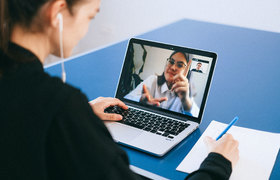TLC2020: tutors’ perspectives on emergency remote teaching
22 September 2020 | Story Niémah Davids. Photo Adobe Stock. Read time 8 min.
Emergency remote teaching and learning wins and stumbling blocks taken from the perspectives of a group of University of Cape Town (UCT) tutors were up for discussion during a segment on day two of the 2020 Teaching and Learning Conference.
The annual conference kicked off on Friday, 18 September, and includes a jam-packed four-day programme. For the first time, the event is taking place online this year.
During a morning session on Monday, 21 September, a group of tutors from UCT’s Faculty of Humanities deliberated on emergency remote teaching and learning following the university’s introduction of the temporary learning methodology in response to the COVID-19 pandemic.
The session was titled “Emergency remote tutoring: a conversation about crisis-responsive tutoring” and it covered some of the group’s experiences to date.
“It was a jarring change. This shift forced us all to navigate new realities, responsibilities and goals.”
Nicole Isaacs, a tutor coordinator for the Humanities Education Development Unit who moderated the discussion, said because of the “unique” role tutors play in teaching and learning, it was important to understand how they responded and adapted to this temporary learning methodology.
“It was a jarring change. This shift forced us all to navigate new realities, responsibilities and goals,” Isaacs said.
Muya Koloko – teaching assistant on the Extended Degree Programme
“The suddenness of the move to emergency remote teaching and learning was a big challenge. We had this set plan – everything was going and suddenly it wasn’t. There had to be a lot of remixing of the material and making sure that tutorials were accessible to as many students as possible.
“We were given an opportunity to start rethinking certain things and to actually start using Vula … to its full potential.”
“We were given an opportunity to start rethinking certain things and to actually start using Vula (the university’s online collaboration and learning system) to its full potential. We no longer had the usual face-based interactions to help students.
“The biggest challenge was making sure things were adapted in a way that was accessible to our students, [and] making sure that material on Vula was displayed well on a computer screen and on a phone [as well as] ensuring that students would not battle if they were learning on one versus the other.
“Students’ needs multiplied and the dynamic became a little more labour intensive. We made sure forums were available … we had set forum topics for the different tutorials and encouraged students [to] engage that way.”
Deborah Aderibigbe – film and media studies tutor
“In the tutor group I was tutoring there were a lot of girls, and for me I think the most challenging aspect was the complaint of the burden of care at home. I think a lot of us moving from face-to-face teaching into that home environment to conduct online learning weren’t prepared for how much of a big factor the burden of care plays at home – especially for young black girls. It was a very difficult thing to navigate. It affected students’ presence in tutorials and their willingness to participate. That was a really big factor.
“This situation is particularly unfair on first years too. We had five weeks on campus and everything shut down and then they went home. I battled because I felt a sense of guilt – we’re asking these [students] for so much and they haven’t been given enough. It’s difficult to teach certain skills, like writing, online. You’re not there to encourage students and tell them they’re doing a good job.”
Diann Selman – convenor of the Texts in the Humanities course
“Access and issues of connectivity, the learning environments and distance learning were the areas I found challenging. Unequal access to resources such as devices (smartphones, tablets, laptops) were at the forefront for me, since this informed the design of the learning materials. The challenge was designing activities and study material which facilitated student engagement on a level as close to that experienced in a face-to-face environment and which addressed queries, while independently navigating the online space.
“We used the lessons tool on Vula to keep students engaged. We included audio and video to deliver engaging content. We used chatrooms and split our tutorial groups into different chatrooms catered to students who wanted to engage online, while at the same time also offering the option to engage on a tutorial via a WhatsApp group.”
Yolanda Tshililo – teaching assistant in the politics department
“Adjusting times to accommodate everyone was a real challenge. You find yourself working at around 18:00 to accommodate students and make sure everyone is in line with content that’s being covered. With face-to-face learning you give students feedback face to face and you can see whether they understand or not. With online learning you’re not sure if students are getting your explanations or not – and that was a challenge.
“I think the emergency remote teaching and learning focus was mostly on students adjusting and hasn’t focused much on tutors and the challenges we have at home.”
“I think the emergency remote teaching and learning focus was mostly on students adjusting and hasn’t focused much on tutors and the challenges we have at home. I had to move from residence and I was reliant on the internet there. Back home I have [intermittent] access to the internet, yet I am still expected to deliver and respond to students on time. If it was balanced, it would’ve been much better.”
Luke Watson – teaching assistant in the English literature department
“Establishing the right tone online was difficult for me. I tried to create a conversational atmosphere in our online forums so that students could feel that this was a space for them to share ideas and ask questions.
“Trying to simulate the classroom environment and the discussions that happen face to face, and doing that online, has also been tricky … I don’t think we’ve managed to get that right because it’s mostly asynchronous, so you can’t respond immediately.
“The responsibilities students take on at home – they bring it with them to the online classroom.”
“Emergency remote teaching and learning has changed the tutor–student relationship in important ways. The emotional labour that’s required is something I wasn’t prepared for. The responsibilities students take on at home – they bring it with them to the online classroom. In one week in July I was communicating with five students who were mourning close family members and at the same time they were trying to complete assignments. There is a responsibility to respond with care and to do so responsibly and not take on too much and overextend yourself.
“Our first years were surprisingly more engaged. We had more students present, contributing and submitting on time. We felt that we could offer a higher volume of work. This semester we offered eight weekly assignments and students are expected to submit four. They’re not expected to submit each week, but there is something there for them to keep them occupied and engaged with the material.”
 This work is licensed under a Creative Commons Attribution-NoDerivatives 4.0 International License.
This work is licensed under a Creative Commons Attribution-NoDerivatives 4.0 International License.
Please view the republishing articles page for more information.










